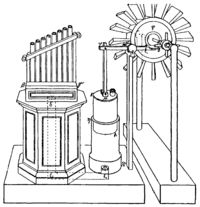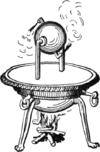Hero of Alexandria facts for kids
Quick facts for kids
Heron of Alexandria
|
|
|---|---|
| Ἥρων | |

17th-century German depiction of Heron
|
|
| Citizenship | Alexandria, Roman Egypt |
| Known for | Aeolipile Heron's fountain Heron's formula Vending machine |
| Scientific career | |
| Fields | Mathematics Physics Pneumatic and hydraulic engineering |
Hero of Alexandria (/ˈhɪəroʊ/; Greek: Ἥρων ὁ Ἀλεξανδρεύς, Hērōn hò Alexandreús, also known as Heron of Alexandria /ˈhɛrən/; fl. 60 AD) was a Greek mathematician and engineer who was active in his native city of Alexandria in Egypt during the Roman era. He is often considered the greatest experimenter of antiquity and his work is representative of the Hellenistic scientific tradition.
Hero published a well-recognized description of a steam-powered device called an aeolipile (sometimes called a "Hero engine"). Among his most famous inventions was a windwheel, constituting the earliest instance of wind harnessing on land. He is said to have been a follower of the atomists. In his work Mechanics, he described pantographs. Some of his ideas were derived from the works of Ctesibius.
In mathematics he is mostly remembered for Heron's formula, a way to calculate the area of a triangle using only the lengths of its sides.
Much of Hero's original writings and designs have been lost, but some of his works were preserved including in manuscripts from the Eastern Roman Empire and to a lesser extent, in Latin or Arabic translations.
Contents
Life and career
Hero's ethnicity may have been either Greek or Hellenized Egyptian. It is almost certain that Hero taught at the Musaeum which included the famous Library of Alexandria, because most of his writings appear as lecture notes for courses in mathematics, mechanics, physics and pneumatics. Although the field was not formalized until the twentieth century, it is thought that the work of Hero, in particular his automated devices, represented some of the first formal research into cybernetics.
Inventions
Hero described the construction of the aeolipile (a version of which is known as Hero's engine) which was a rocket-like reaction engine and the first-recorded steam engine (although Vitruvius mentioned the aeolipile in De Architectura some 100 years earlier than Hero). It was described almost two millennia before the industrial revolution. Another engine used air from a closed chamber heated by an altar fire to displace water from a sealed vessel; the water was collected and its weight, pulling on a rope, opened temple doors. Some historians have conflated the two inventions to assert that the aeolipile was capable of useful work, which is not entirely false, air containing a trace of water vapor. However, this engine is far from a pure aeolipile.

- The first vending machine was also one of his constructions; when a coin was introduced via a slot on the top of the machine, a set amount of holy water was dispensed. This was included in his list of inventions in his book Mechanics and Optics. When the coin was deposited, it fell upon a pan attached to a lever. The lever opened up a valve which let some water flow out. The pan continued to tilt with the weight of the coin until it fell off, at which point a counter-weight would snap the lever back up and turn off the valve.
- A wind-wheel operating an organ, marking the first instance in history of wind powering a machine.
- Hero also invented many mechanisms for the Greek theatre, including an entirely mechanical play almost ten minutes in length, powered by a binary-like system of ropes, knots, and simple machines operated by a rotating cylindrical cogwheel. The sound of thunder was produced by the mechanically-timed dropping of metal balls onto a hidden drum.
- The force pump was widely used in the Roman world, and one application was in a fire-engine.
- A syringe-like device was described by Hero to control the delivery of air or liquids.
- In optics, Hero formulated the principle of the shortest path of light: If a ray of light propagates from point A to point B within the same medium, the path-length followed is the shortest possible. It was nearly 1,000 years later that Alhacen expanded the principle to both reflection and refraction, and the principle was later stated in this form by Pierre de Fermat in 1662; the most modern form is that the optical path is stationary.
- A stand-alone fountain that operates under self-contained hydro-static energy; now called Heron's fountain.
- A cart that was powered by a falling weight and strings wrapped around the drive axle.
- Various authors have credited the invention of the thermometer to Hero. The thermometer was not a single invention, however, but a development. Hero knew of the principle that certain substances, notably air, expand and contract and described a demonstration in which a closed tube partially filled with air had its end in a container of water. The expansion and contraction of the air caused the position of the water/air interface to move along the tube.
- A self-filling wine bowl, using a float valve.
Mathematics
Hero described a method (now known as Heron's method), for iteratively computing the square root of a number. Today, however, his name is most closely associated with Heron's formula for finding the area of a triangle from its side lengths. He also devised a method for calculating cube roots. He also designed a shortest path algorithm, that is, given two points A and B on one side of a line, find C a point on the straight line that minimizes AC+BC.
In solid geometry, the Heronian mean may be used in finding the volume of a frustum of a pyramid or cone.
See also
 In Spanish: Herón de Alejandría para niños
In Spanish: Herón de Alejandría para niños
- Heronian triangle
- Heronian mean


